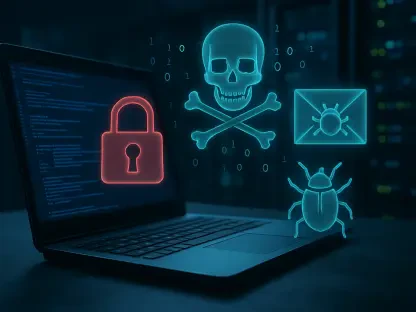Emerging cyber warfare techniques continue to disrupt global security landscapes, with destructive malware standing at the forefront. A recent and significant addition to this arsenal is PathWiper, a destructive malware strain employed in attacks on critical infrastructure in Ukraine. The strategic use of such technology in geopolitical tensions underlines both the sophistication of cyber threats and the vulnerabilities of current defenses. As these attacks escalate, understanding the capabilities and implications of malware like PathWiper becomes paramount.
Context and Development of Destructive Malware
Destructive malware refers to software designed to inflict severe damage on data and systems, rendering them inoperable. Historically, such malware has evolved from nuisance-level disruptors to complex agents of cyber warfare. This perilous transformation reflects an increased prioritization of cyber capabilities as crucial elements of national security. Today, the relevance of destructive malware cannot be overstated, given its capacity to undermine critical infrastructure globally.
The historical evolution of malware as a tool of aggression has been shaped by increasing geopolitical tensions and technological advancements. The ability to dismantle essential services—from financial networks to power grids—demonstrates its profound implication on global cybersecurity. Sectors such as energy and telecommunications, foundational to modern society, are often the primary targets, with motivations ranging from financial gain to political disruption.
Characteristics and Mechanics of PathWiper
PathWiper exemplifies the sophistication of contemporary malware through its calculated deployment techniques and destructive capabilities. Understanding how such malware functions provides insight into its potency and potential countermeasures.
Deployment Methodologies
The deployment of destructive malware like PathWiper relies on precise techniques designed to circumvent security measures. Tools such as phishing and social engineering tactics exploit human psychology to gain system access, while leveraging vulnerabilities in software creates entry points for malware execution. In the case of PathWiper, attackers employed a legitimate endpoint administration tool to emulate benign system operations, allowing malware deployment with deceptive stealth, capitalizing on existing IT infrastructures.
Data Destruction Techniques
The malevolent behavior of PathWiper is particularly evident in its data destruction and corruption methods. This malware targets system functions like the Master Boot Record (MBR) and New Technology File System (NTFS), gating data access upon execution. PathWiper distinguishes itself by identifying and logging valid records of connected devices before corrupting these critical system artifacts. This method not only maximizes data loss but complicates recovery, demonstrating advanced tactics in rendering systems inoperable.
Trends in Destructive Malware Utilization
Recent developments in malware technology signal a shift toward increased sophistication and integration of evasion strategies. New strains like PathWiper highlight not only technical advancements but evolving threats in the context of global cyber warfare. Such innovations reflect a strategic shift among nation-states, where cyber capabilities stand as potent instruments within geopolitical arsenals.
Moreover, the geopolitical landscape sees destructive malware increasingly employed as a tool of state-sponsored aggression. Incidents involving malware such as WhisperGate and HermeticWiper underscore a concerted effort to disrupt adversary infrastructures. The active deployment of these tools signals a broader trend where digital warfare complements traditional military strategies, reshaping how conflicts unfold on the global stage.
Practical Implications and Industry Impact
The real-world applications of destructive malware like PathWiper demonstrate its disruptive potential across multiple industries. Energy grids, financial institutions, and telecommunications networks prove notably susceptible, given their role in sustaining societal functions.
The persistent nature of these cyber threats is illustrated in various high-profile incidents targeting Ukrainian critical infrastructure. In particular, coordinated attacks deployed through PathWiper emphasize the calculated disruption of essential services, reinforcing concerns about the adequacy of existing cybersecurity measures. These cyber offensive efforts reflect broader strategic aims tied to geopolitical conflicts, providing a stark reminder of the stakes in guarding critical infrastructures against malicious cyber activities.
Overcoming Challenges in Malware Defense
Efforts to combat the ongoing threat of destructive malware face significant obstacles. The highly sophisticated tools employed in these attacks challenge current detection and prevention capabilities, necessitating advancements in security systems and protocols. Additionally, the evolving nature of these threats poses a continuous challenge for regulatory bodies and legal frameworks tasked with cyber oversight.
Efforts to adapt to these threats involve the deployment of advanced detection technologies and evolving cybersecurity protocols. Concurrently, international collaboration emerges as a crucial facet of tackling these sophisticated threats, advocating for collective intelligence sharing and joint defensive strategies. The rapidly shifting threat landscape demands continuous innovation in both technology and policy to effectively mitigate risks from aggressive malware attacks.
Considerations for PathWiper’s Influence and Future
As cyber threats continue to evolve, the future trajectory of destructive malware remains a dynamic aspect of cybersecurity. Anticipated developments in both offensive malware technology and defensive measures will significantly shape this landscape. Ongoing research in creating resilient defense systems promises breakthroughs geared toward minimizing the impact of such threats.
Furthermore, the role of international policy and cooperation is expected to gain prominence, with treaties and agreements forming the basis for collective cybersecurity efforts. This global response aims to promote a unified stance against the destructive forces of cyber warfare, advocating for peace and stability amidst technological advancement. The proactive engagement of international communities will likely define the future balance between digital aggression and defense.
In assessing the current battle against destructive malware, it is clear that strategic innovation must accompany technological advancements. The critical state of cybersecurity necessitates a proactive and adaptable defense, safeguarding essential infrastructures from malicious threats. The insights drawn from the PathWiper evolution emphasize both the resilience required to withstand cyber threats and the continuous adaptation needed to maintain security in an ever-changing digital world.









